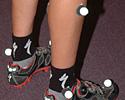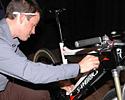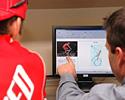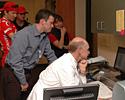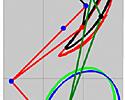
Recently on Cyclingnews.com |
Medically-based bike fitting, November 24, 2006The Specialized fit
No matter what your discipline, rider comfort is a crucial element in the cycling industry. The correct bike geometry is an increasingly topical area - one made harder by discrepancies in leg lengths. Rob Karman observed how industry expert Dr. Andy Pruitt helped former World Cup Champion Christoph Sauser overcome the issue.When Specialized signed then World Cup Champion Christoph Sauser late last year, one of the benefits the Swiss cross country star gained by joining the Big Red S was the close connection between the global bicycle and component manufacturer and Dr. Andy Pruitt, one of the world's foremost authorities on medically based bike fit. After hearing raving reviews from Gunn-Rita Dahle about how Dr. Pruitt helped increase her efficiency on the bike, Sauser was keen to visit the good Doc and see what he could do for him.
Upon entering Dr. Pruitt's offices and strolling down the halls at the Boulder Center for Sports Medicine, you can't help but stare in awe at the collection of jerseys and posters lining the walls from famous athletes, each one adorned with a handwritten note thanking Dr. Pruitt for his help, a testament to not only the caliber of the athletes with which he works, but the caliber of Dr. Pruitt's work as well. The fit started with a physical exam to test Sauser's flexibility and
discuss any problems he was experiencing on the bike. While he was not
experiencing any pain on the bike (other than the oxygen-debt suffering
he inflicts upon himself), he did suffer from back pain and saddle sores
in the past that were effectively treated by an osteopathic physician.
He also has a known leg length inequality of approximately 2cm. In the case of Sauser, his right tibia (or shin bone) is 15mm shorter than his left, while his right femur (thigh bone) is 2mm shorter than his left. Overall his hips are crooked by 18mm, the missing 1mm in the math being caused by pronation (rotation) of his foot. 18mm is a lot of difference in leg length, especially for an elite level rider such as Sauser who spends an enormous amount of his waking hours pedaling a bike. Dr Pruitt's office typically ends up correcting about half the distance of a leg length inequality while letting the body compensate for the remainder.
While all of this was going on, biomechanist Todd Carver and Sauser's personal mechanic were busy setting up his new S-Works Epic Carbon on an electro-magnetically braked ergometer and covering anything reflective on it with tape. This is done to prevent interference with the 3D data capture they were about to perform on Sauser's pedaling position. The optical 3D capture system they use consists of several video cameras arranged around the rider. Each of these cameras has a ring of red LED lights mounted around the axis of the lens to illuminate the rider with red light and infrared pass filters so that only infrared or near infrared light reaches the camera. Retro-reflective markers are strategically placed on points of interest in order to capture positional data about the rider's knees, hips, ankles and toes throughout their pedal stroke...
After a few seconds of video capture while riding on the ergometer, powerful computer software interpolates the data captured by the cameras and makes a three dimensional model of your pedal stroke that can be viewed from the front, side and top. The resulting file is kind of like a stick figure video game of you riding a bike. Carver and Dr. Pruitt can move to any point in the pedal stroke and analyze knee, hip and ankle angles, and more. This is the same technology used by the movie industry to capture natural human movement to aid in making highly realistic computer animation sequences. Once Sauser was warmed up on his bike and fitted with the appropriate retro-reflective markers, Carver and Dr. Pruitt were ready to capture the first set of data. This would be used to determine how straight his position was and also to provide a frame of reference to compare with later captures after changes to his position. Sauser was asked to ride at a perceived exertion level of 7 (on a 1 to 10 scale) and his output wattage was noted. Curtains were drawn around him to prevent stray light from interfering with the data capture and the computer recording system was switched on.
A few minutes later a small crowd had gathered around Mr. Carver's computer monitor to get a closer look at the video game stick figure version of a mountain bike World Cup winner's pedaling technique. It was interesting to see that Sauser compensated very well for his large leg length discrepancy with extra movement in his ankle throughout his pedal stroke. Improvement could be made, though, and with it, an increase of efficiency and power. Dr. Pruitt decided to have custom cycling-specific orthotic insoles made for Sauser with 1.5 mm of forefoot cant. These, combined with the additional 1.5 mm of cant built into his Specialized Body Geometry shoes would align his feet, ankles and knees for more efficient power transfer on the bike.
Additionally, Specialized made Sauser a pair of custom Body Geometry shoes with a 5mm lift in the right shoe. This was in contrast to the 1.5mm cork spacer that Sauser had been using in his shoe before, a spacer so small in comparison to his leg length inequality that Dr. Pruitt likened it to "spitting in the ocean". With road shoes and pedals, spacers are often put in between the shoe and the cleat, but in the case of mountain bike shoes, this would make the cleat stick out further than the treads which affect traction on the occasional hike-a-bike section found on many courses. The result? After two months of riding in his new position, Sauser had felt a noticeable improvement. "Since I ride [in] the Body Geometry shoes with a 5mm higher sole in my right shoe, I feel much more straight and balanced out," he explained. "My leg length imbalance [has] always been a problem, but with the new adjustment, both legs work more equally. My shorter and weaker leg is not getting as tired as it used to. The special inner sole with more support on the "foot tunnel" gives me the support I need, especially when I am riding off the saddle. The legs pedal straight, and I have the direct power transmission to the pedals!" Big words of praise from someone who obviously had plenty of power on the bike before seeing Dr. Pruitt.
What this means for youThis process obviously has many benefits for a rider like Sauser, including increased power and decreased occurrence of injuries. However, all cyclists can stand to gain from a medically- and physiologically-based fit such as what is performed by Pruitt and Carver at the Boulder Center for Sports Medicine, particularly those that have suffered from chronic and nagging pains resulting from being on the bike. While it's probably true that you may not ever earn that pro contract, there's no reason not to maximize your own personal potential regardless. PhotographyFor a thumbnail gallery of these images, click here Images by Rob Karman
|


